The Samsung Galaxy S6 and S6 edge Review
by Joshua Ho on April 17, 2015 9:00 AM EST- Posted in
- Smartphones
- Samsung
- Mobile
- Galaxy S6
- Galaxy S6 Edge
Display
As we briefly discussed in our look at the specifications, the Galaxy S6 line introduces a newer generation of AMOLED displays, which is said to increase maximum luminance to 600 nits. Samsung claims that this was achieved with the use of new materials, which is likely necessary in order to sustain power efficiency improvements. It doesn't seem that AMOLED is uniquely suited to high resolution, but rather that Samsung Display Corp. is managing to dramatically improve how they make AMOLED displays with every year that offset power consumption increases from higher resolution displays.
To find out how Samsung did, we use SpectraCal's CalMAN 5 Ultimate, in addition to X-Rite's i1Pro2 Basic to characterize displays as accurately as possible.
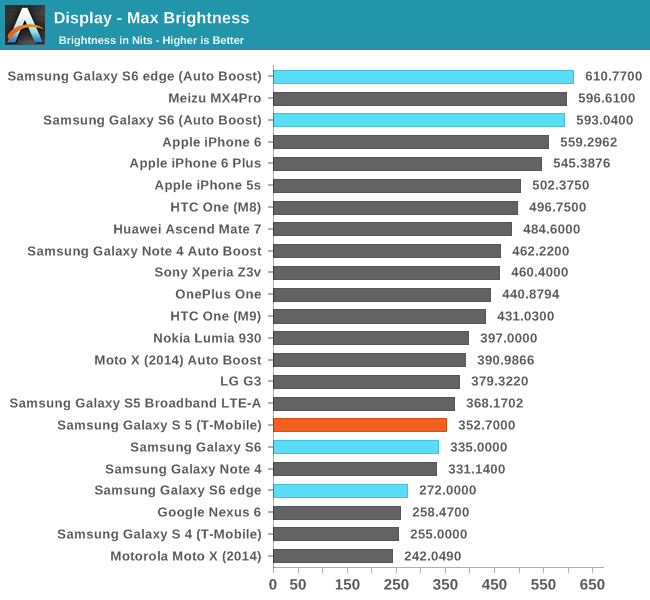
From the results Samsung's claims of a 600 nit display are valid in this case, which is a 100% APL white display. It's important to note that achieving this requires the use of auto-brightness, and that manual brightness is limited to a much lower brightness to reduce power usage, here the S6 sees similar maximum brightness as the S5. The S6 edge disappointingly only achieves 272 nits in this mode, a rather low value. I saw color balance shift dramatically in auto-boost mode, which suggests that this operating mode is likely less efficient than manual brightness. As an explanation, we've seen that colors are controlled in AMOLED by voltage while brightness is controlled by PWM (pulse width modulation). As with most recent AMOLED displays, there's no DC bias to the pixels so the contrast really is infinite instead of just a very large number when displaying black.
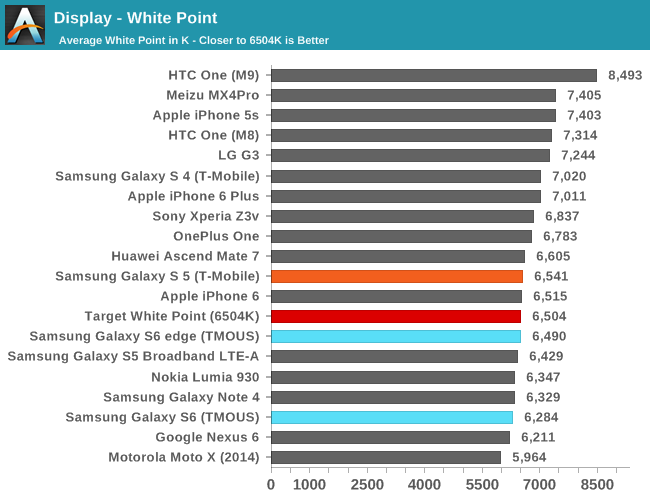

Moving on to grayscale, we can see that Samsung has done a pretty good job of controlling the white point and gamma across the saturation sweep, even if green is slightly dominant in both displays. We can also see that there is variation across displays as the S6 edge is closer to neutral while the S6 sample tends a bit warmer.
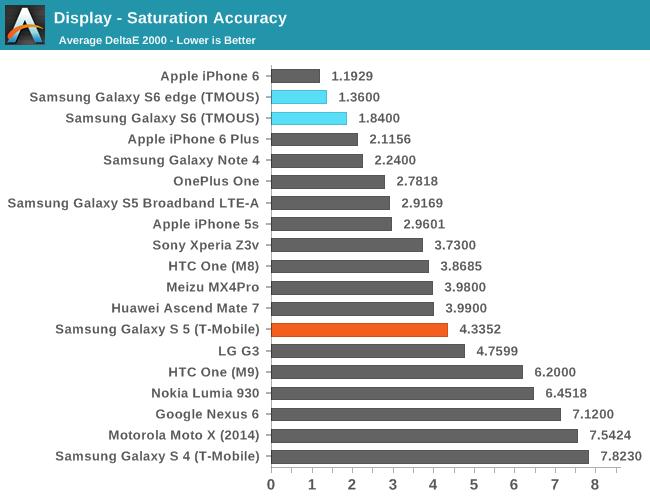
In the saturation sweep, both displays do an incredible job. I really don't have anything else to say here, because there's really no way to improve on the level of calibration Samsung has done on this display. Unless Samsung calibrates every single display in production, which is wildly impractical and effectively impossible to do, this is as good as it gets for a mass-produced device. Improving past this point will also be incredibly difficult to perceive, which means there's no real reason to go any further.
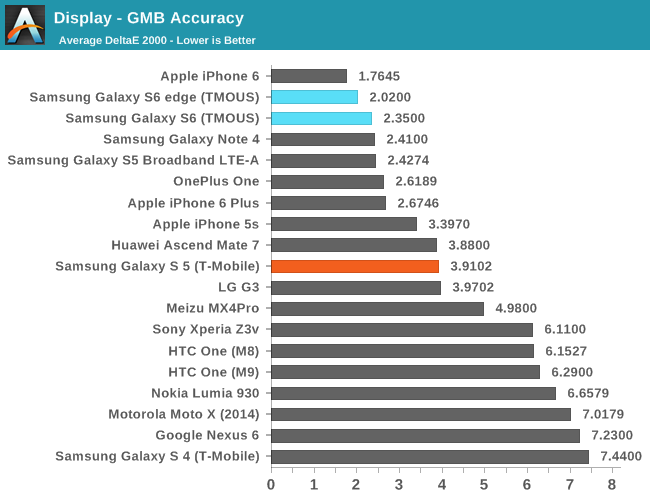
In the Gretag MacBeth ColorChecker, we can get an idea for overall color accuracy, which paints a picture similar to the saturation test. The only real problem I've noticed with these displays are the viewing angles, which can produce color shifting when the display is tilted. This is a bit of an issue on the edge variant as I can see that the edges of the display appear somewhat green when viewed head on, but otherwise there are no real issues to be seen here.
Overall, from a color standpoint it’s looking like Samsung has made one of the best displays available on the market today. Color accuracy is at the point where it’s pretty safe to say that the calibration doesn’t have clear color errors, and the peak brightness of the display is incredibly high. The 1440p resolution helps to compensate for the PenTile subpixel layout so in practice it’s effectively impossible to make out any pixels or the subpixel pattern. The contrast remains infinite as with most modern AMOLED displays, and overall it’s really hard to find any issue with the Galaxy S6’s display at first.
However while the S6 edge seems to be without any issues, the S6 does have some odd display issues that can be seen in direct sunlight as seen in the photo above. To be clear about this the photo above is a simple white screen, which should make the image completely homogeneous but instead there are two visible vertical lines and another jagged horizontal line that appear across the display. Inspection under a light microscope doesn’t really reveal what’s causing this, but the defect is quite visible in practice as seen in the photo above. I suspect that defects are rare, and in any condition other than direct sunlight I can’t see this visual problem.
While trying to see what this kind of defect looked like under a microscope, I also went ahead and took some photos of the subpixel pattern. As far as I can tell, it looks like the green subpixels have a bit more variance than what we’re used to as they tend towards oblong shapes rather than circles, which is likely due to the much tighter pixel density. It seems that this variance may cause some color shifting in certain units, which seems to remain a potential problem with Samsung's AMOLED displays. The pixel fill factor still remains surprisingly low when compared to LCDs, which usually have much higher active area. Due to the subpixel arrangement and some other differences in the display design, color shifting also remains higher than one would expect from LCD displays that are found in phones like the iPhone 6.
The final test that I managed to run on the Galaxy S6 is the brightness vs APL test, which shows the advantage of AMOLED’s emissive nature as it can dynamically increase brightness if the entire display isn’t showing a white screen. As a result, this means that in low APL scenarios like dark movie scenes and app themes it’s possible to see a maximum brightness closer to 700 nits or higher. However, in practice the display’s practical brightness is closer to 600 nits.
Overall, the display is still one of the best on the market, but I would be a bit concerned about fill factor for VR applications as that was a problem on the Note 4. Issues like purple smearing have been resolved, but there are still some problems with the display such as color shifting with changes to viewing angles and some variability in display quality from unit to unit. With this generation I suspect Samsung is either meeting or exceeding the best LCDs in quality, and with the next generation of AMOLED it’s likely that high end smartphones will have to migrate to AMOLED to remain competitive.



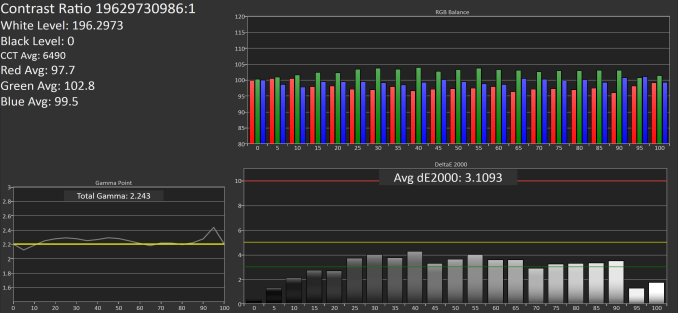
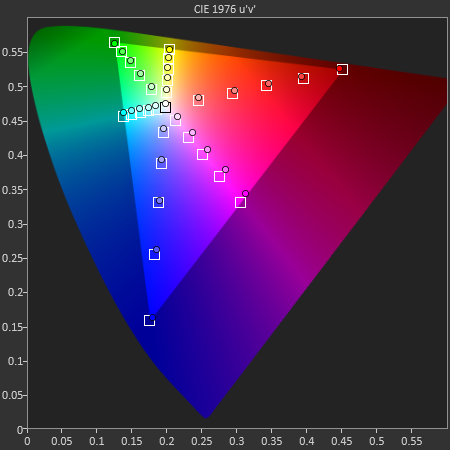
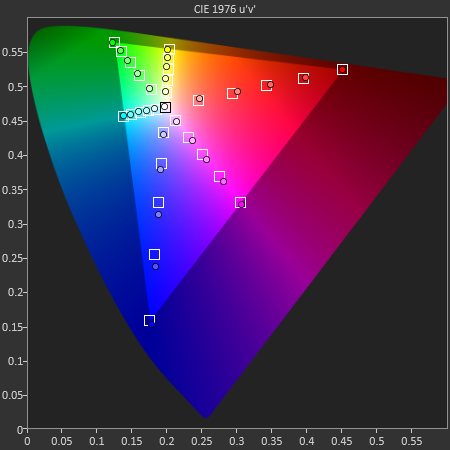
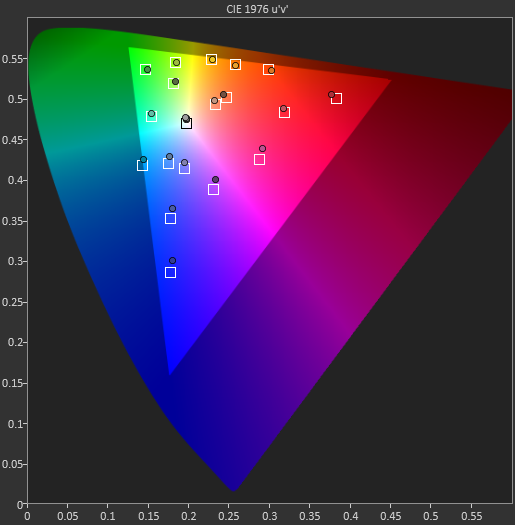

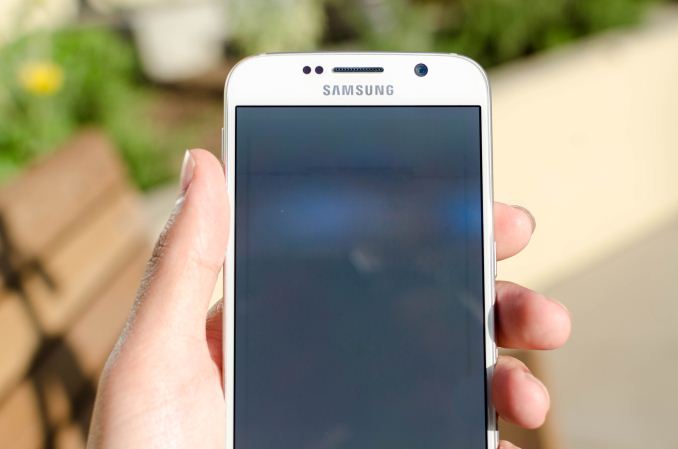
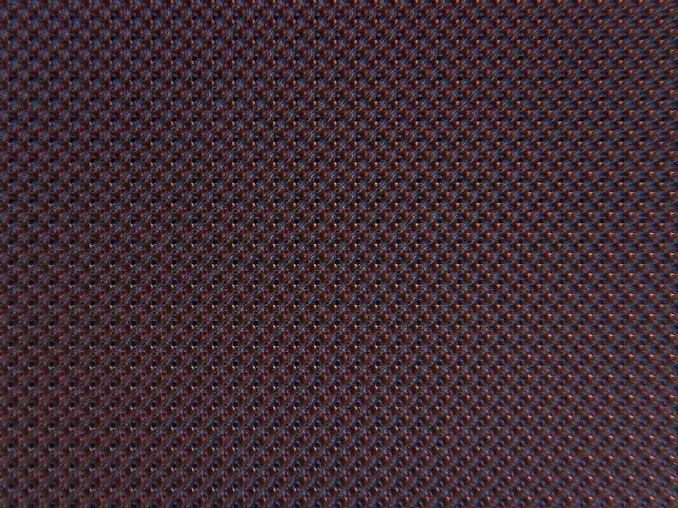
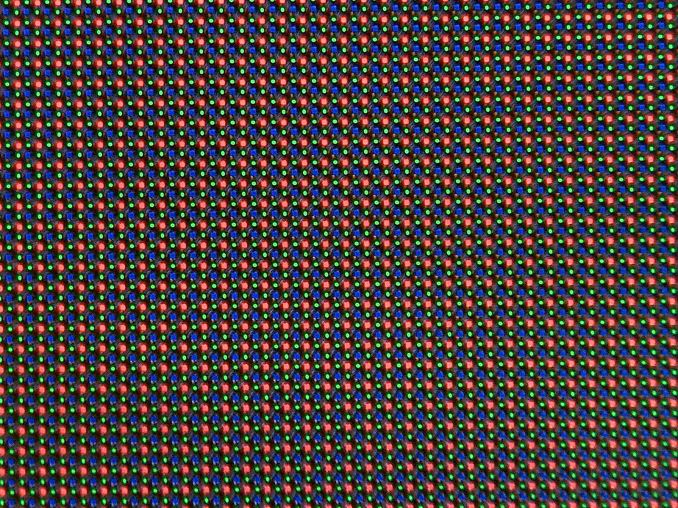
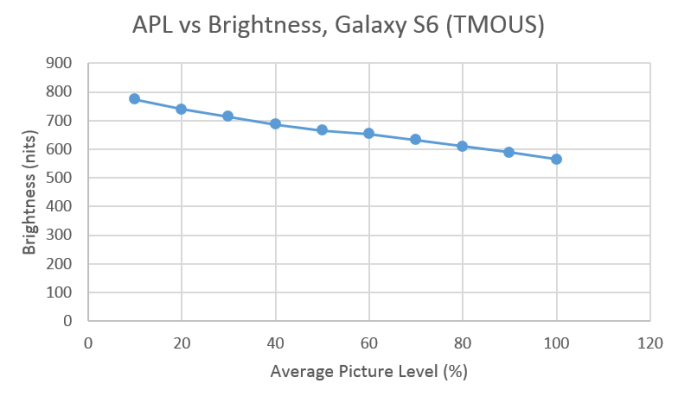








306 Comments
View All Comments
FlushedBubblyJock - Friday, April 17, 2015 - link
That's what happens when "brainy", stuck up, clueless, unoriginal nerds, have no GF's and get their "feel ups" off their cellphone."Oh she feels so cheap !" " She should feel better in my hands"...
Thus, we now have the whined for apple crap.
mkozakewich - Friday, April 17, 2015 - link
that feel when no sdFickleBJT - Saturday, April 18, 2015 - link
Would you buy a car that looked like it was made out of plastic?Remember, these are ~700 dollar phones. Asking for good materials and workmanship is perfectly reasonable. I used to own a GS3 and the paint started coming off of it after just a few months. It made the phone look awful. I would much rather have a nicer feeling and looking phone. Granted, they could have put an SD slot in there, at least in the normal variant.
loki1725 - Saturday, April 18, 2015 - link
"Would you buy a car that looked like it was made out of plastic?"Yes. If you've bought a mainstream car in the last ten years, it probably does have plastic in it.
Would you buy a car where the body was made of glass?
lilmoe - Saturday, April 18, 2015 - link
That's just a bad analogy bro...Kvaern2 - Sunday, April 19, 2015 - link
The analogy is bad yes but his point is nevertheless valid.akdj - Sunday, May 31, 2015 - link
Not really, not when some of the best, fastest and finest cars in the world are made from plastics, 'glasses' (plexi, etc) & carbon fibermaxxbot - Wednesday, April 22, 2015 - link
So "nerds" are the driving force between Samsung and Apple's huge sales numbers? There sure must be a lot of "nerds" out there.FlushedBubblyJock - Friday, April 24, 2015 - link
Pride, ego, status, selfie love.Spend the big bucks for the premium status symbol, then others will love you too.
I really don't think nerd is any part of the equation - clueless herd sheeping seems to be the case.
Margalus - Friday, April 17, 2015 - link
just the opposite for me. no removable sd card is a non issue with the base model having 32GB, and 64 and 128GB models available. But no removable battery with android is a show stopper. What good is a "mobile" phone if it goes dead in 4 hours while you are out and can't charge it?as for the sd card, my s4 has 9.5GB or internal and a 64GB external sd. All together I have used up about 30GB of storage over 2 years.. so a 64GB or 128GB model would be fine without an external sd card. But with a dead battery and no way to replace it, the phone is useless.